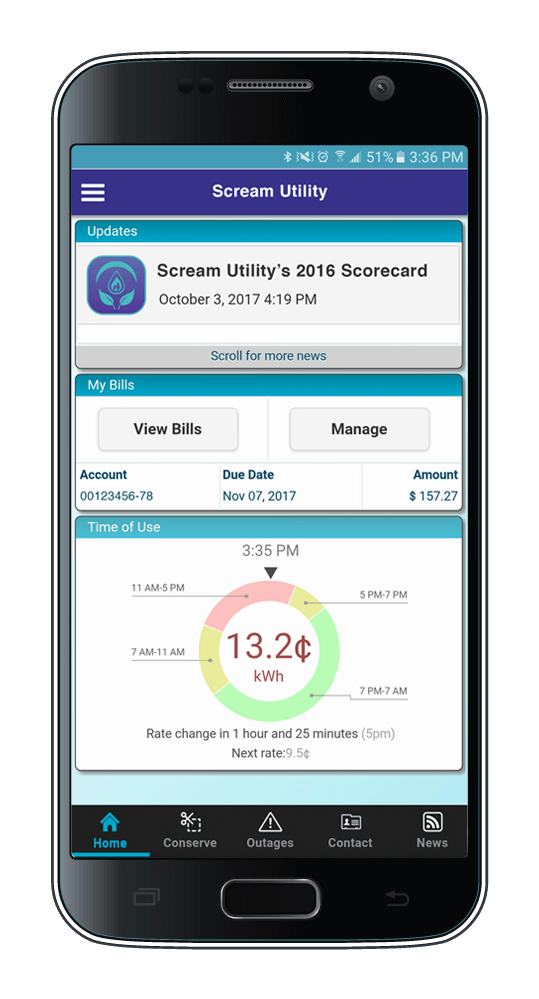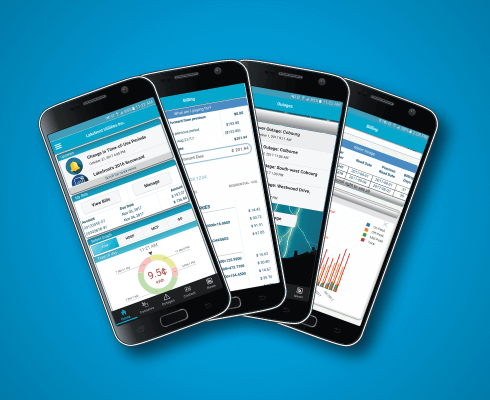Case Study
Mobile Customer Engagement – Utility Case Study
Authored by: Screaming Power
Mobile Customer Engagement – Utility Case Study
Introduction
This Case Study focuses on a roll-out of a Utility-branded mobile solution focused on customer engagement. A roll-out of this kind has many challenges – including operational, security, accuracy, analytics, privacy, policy, IT, administration and education. This Case Study examines the challenges and the outcome of providing a mobile customer engagement solution from a templated cloud, Mobile App Solution set for iOS and Android mobile devices.
Screaming Power has been developing a mobile solution set for several years and partnered with a Utility (Lakefront Utilities), its Utility Cooperative (The CHEC Association) and government entities to create a production-ready Utility Solution. The goal was to bring into production a cost effective, flexible, innovative solution that meets the needs of a single utility, while creating a production-ready template for multiple utilities of any size.
There are multiple implementation elements to be looked at in this Case Study that are presented in this list:
- Can Screaming Power use its existing IP to create a cost effective “canned” solution for multiple Utilities?
- What is the timeframe needed to create a branded solution and what unknowns will be discovered that may cause roadblocks or even barriers to the technology used?
- Are the Utilities experienced in the potential capabilities of mobility to assist in the development of a mobile solution and in managing information and customer interaction, or will they require training and education?
- Can the solution be implemented without costly changes to the Utility’s existing IT infrastructures?
- At roll-out, does the platform meet initial expectations?
- Are there any anticipated future benefits using mobile technology?
Overview
The Intellectual Property that Screaming Power started with had 3+ years of research and development in it prior to the project initiation and encompassed over 550,000 lines of code that managed various aspects of the application, server and features needed for the Utility Solution. This foundation allowed Screaming Power to provide Lakefront Utilities a Prototype Solution in a matter of weeks for evaluation and allowed the Utility to actively participate in changing the solution to meet its particular needs.
The Utility and Cooperative became engaged quickly. It was realized early on that the Subject Matter Experts (SMEs) involved in the development of the app were not technically advanced in mobility, so a process was put in place for the individuals to always have a version of the app in the palm-of-their-hand to better understand the progress and comment on needs related to the customer and the Utility. Once a Mobile App Development Process was put in place, regular updates were provided directly to their devices and short meetings were held where all parties participated in decisions and feedback.
At this time, Screaming Power also began re-creating a back-office admin, so the Utility could easily manage the App and its users. This Admin area had one focus – to reduce the manual management of information / data and allow the Utility to properly communicate with its customers.
As the back-office admin evolved, it became apparent that there was a need to use machine learning to resolve data issues, as Screaming Power did not want to request changes to the Utility’s IT systems as costs start to escalate and timelines are affected. Once machine-learning algorithms were put in place to validate data, information directed to the Utility’s customers was properly reviewed and validated before the information went to the app. All parties worked together, so the algorithm had a complete set of data to work from, finally achieving automation of information flow and presentation.
As solution development continued within the app / server / connectivity, security and privacy issues came up on a continual basis and discussions around process, data flow, access and authorization was constantly challenged and resolved.
With the existing IP, it took 7 months to complete the roll-out. Issues continuously came up came up with market / policy changes, mobile Operating System changes, and new requirements, as the SMEs began to see the power of the solution and Screaming Power looked to ensure the solution would accommodate future enhancements.
Results
As of November 2017, The Solution is available for download for iOS and Android. There were many observed results that were not expected:
- When it came to mobile expertise, the Utility SMEs became more engaged and aware of the potential of mobility. By the time the solution was rolled out, the Utility was able to envision the future possibilities and was very attentive to what the customers would be interested in seeing next.
- The original code produced by Screaming Power for the project was optimized and re-factored, as new methods to deal with features and situations were found and the mobile community created better solutions that could immediately be utilized.
- The machine-learning algorithms exceeded their initial goals, as data formatting anomalies were discovered and resolved for over 280 different formats. Without machine learning, processing the data would have been a roadblock to a production roll-out.
- Bill display design was taken from the Ministry of Energy’s bill design concepts to be rolled out late 2018. The Utility has implemented them now and can easily change them with little effort to conform with future requirements.
- With Version 1 in production, new issues are being found and resolved, and enhancements are being added in real-time or require a new version to be sent to the App worlds.
- Time spent building out a proper administration section to manage the solution was indispensable as it saves time and money. The Utility does not have to go back to Screaming Power to manage typical content updates and additions.
- The team continues to work closely as the solution rolls-out. In fact, there is even more active communication, as there are now more champions out there to help with the evolution of mobility in the Utility industry.
- With the modifications made during this roll-out, new Utility roll-outs can be made in weeks not months.
- Industry, market, policy and technology change greatly effects the solution. It was important to continually build to allow for future changes, so that the solution can evolve as the market evolves.
- Screaming did roll-out a solution that met the requirements established at the beginning. There were many new features added as the product evolved and many other ideas / features being reviewed. These features will be evaluated with the app users.
Q & A's
It’s always interesting to provide individuals with some questions.
We asked our SMEs (Subject Matter Experts) from the Utility and Cooperative these questions.
SME-1: Yes – The project demonstrated the “behind the scenes” elements of APPs, their flexibility and analytics.
SME-2: Yes. Prior to beginning this project, the deliverables I had in mind were fairly basic. It was not until we got to the development stage that I realized the possibilities that mobility presents for enhanced customer service.
SME-1: The largest element was the fact that the template for one APP is not easily transferred to another – One LDC to another. The setup remains considerable because of how complex the Utility structure is.
SME-2: Billing integration. The App needed to work with our Billing system and there were issues getting the 2 systems to communicate. After much perseverance and resourcefulness, the issue was resolved.
SME-1: The end results exceeded expectations with regards to functionality. The APP provides more interaction than anticipated in the first phase.
SME-2: Every time I use the App I am impressed at how slick, interactive and professional it is.
SME-1: I would have specified the specific areas more from a functional basis. This may have expedited development. However, as I was not familiar with the capabilities of APPs this would have been hard to do.
SME-2: I would have got more departments from the Utility involved right from the start. It would have been useful to poll them for ideas on features within the App during the first phase, as opposed to bringing them into the process midway through.
SME-1: Good relationships all the way through the project. Of course, we know each other better now and certainly there is respect with the capabilities they have been able to demonstrate.
SME-2: SPI was great to work with right from the beginning.
Conclusion
The future of mobility holds multiple benefits for the Utility, the customer and the market. This application opens the door to better customer engagement and innovation. It also allows the Utility to look at mobility as a potential cost-saving instrument and gives the customer a more modern way to manage their energy information and interact with the Utility. The visibility, enhanced communications and cost-effective integration is only limited by the needs of today. The most important thing is the solution is set up to assist everyone with tools for tomorrow. As today’s technologies evolve, the Utility has the option to see how it can cost-effectively engage mobility to share information and help the customer.
As the solution evolved with its Existing IP, there were many unexpected challenges that were overcome through teamwork and technology. Screaming Power did create a cost-effective solution for multiple Utilities to take advantage of in the future. The Utility gained experience in mobility and now has a full appreciation of its capabilities. For future implementations, costs are anticipated to be greatly reduced as the implementation was completed without burden to the Utility’s existing IT infrastructures and our mobile templates were enhanced.
The roll-out, exceeded expectations and there are anticipated future benefits using mobile technology to better communicate with the customer. For example, it is anticipated that bill generation costs will be significantly reduced as more and more customers adopt mobility over time, no longer requiring a paper bill.


